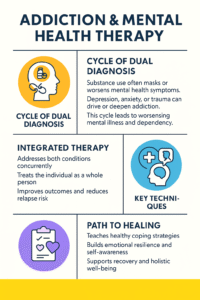Managing addiction and mental health challenges takes patience, support, and the right therapeutic approach. Since these issues often overlap, effective treatment addresses emotional and behavioral patterns. The right therapy can help manage triggers, regulate emotions, and rebuild a healthier sense of self. In this guide, I’ll outline trusted, research-based techniques—like CBT, mindfulness, and trauma-informed therapy—and explain how each supports lasting recovery and mental wellness.
Why Therapy Techniques Matter in Addiction and Mental Health Recovery
Dealing with addiction or mental health struggles can feel isolating, and it’s easy to think that willpower alone is enough. The truth is, structured therapy techniques give people practical skills to manage cravings, stress, thought patterns, and intense emotions. The mental health field keeps changing, but some therapy approaches have stuck around because they’re backed by research and real-life results. Therapists regularly monitor which methods work best for their clients, aiming to step up the success of recovery strategies.
The National Institute on Drug Abuse points out that behavioral therapies continue to be the most popular treatment methods for addiction and mental health concerns. Depending on someone’s unique life circumstances, these methods can be adjusted or mixed, which makes them pretty flexible. A therapist who customizes the approach for each individual often helps increase the odds of change sticking for the long haul.
Core Therapy Techniques for Addiction and Mental Health Issues
The world of therapy techniques is vast, but let’s zoom in on the most popular and research-backed options. Each has its strengths, and many therapists blend several to help their clients get the best results.
- Cognitive Behavioral Therapy (CBT) focuses on changing unhelpful thoughts and behaviors. Therapists help clients spot negative thinking patterns that could be fueling addiction or depression, then coach them through swapping these with healthier perspectives. For addiction, CBT also breaks down triggers and gives people tools to handle cravings without relapsing.
- Motivational Interviewing (MI): This method builds motivation for positive change. A therapist listens, asks thoughtful questions, and helps clients talk through their own goals for recovery. I’ve watched MI help people move from feeling stuck to actively building healthier lives.
- Dialectical Behavior Therapy (DBT): Created for borderline personality disorder, DBT’s skills for regulating emotions, tolerating distress, and communicating better also work really well for addiction and mental health. Many rehab programs now use DBT for those battling mood swings and substance cravings.
- Contingency Management (CM): CM uses rewards or vouchers to support people in sticking with positive behaviors, such as staying sober or showing up for therapy. This can be especially helpful when motivation is low and extra encouragement is needed.
- 12-Step Facilitation Therapy: This technique brings people into the basics of 12-step recovery programs (like Alcoholics Anonymous or Narcotics Anonymous), helping them plug into support groups that can be key for long-term change.
Getting Started: What to Expect from Therapy
The first session is usually pretty relaxed and judgment-free if you’re new to therapy. Therapists often ask questions about your background, struggles, goals, and what you’d like out of therapy. They use this information to suggest one or more therapy approaches that could fit your needs or preferences.
Some terms you might encounter early on include:
- Individual therapy: Private, one-on-one counseling with a seasoned therapist.
- Group therapy: Sessions led by a therapist but with several people tackling similar struggles, offering mutual support and shared ideas.
- Family therapy involves members working through relationship dynamics and building a strong support system. This is very useful for addiction recovery.
Quick Guide: Steps to Find Helpful Therapy Techniques
You don’t need to be a therapy pro to benefit—just knowing what to look for helps. Here’s a step-by-step rundown to guide you:
- Consider Your Goals: Are you hoping to reduce cravings, manage challenging emotions, or mend relationships? Figure out what you want from therapy.
- Research Different Approaches: Check out CBT, DBT, or MI methods. Look for videos or quick guides from licensed pros to see what might appeal to you.
- Reach Out to a Trusted Therapist: Most therapists offer a first call or assessment where you can ask about their style and the approaches they specialize in.
- Stay Open and Honest. Share past experiences—what worked and what didn’t. This helps shape the next steps your therapist recommends.
- Give It Some Time: Therapy styles can take a bit to click. Don’t worry if the change doesn’t show up instantly.
These steps will help you track down good info and feel more in control while seeking support. The process can seem daunting, but each step brings more clarity and confidence.
Things to Keep in Mind before Starting Therapy for Addiction or Mental Health
Starting therapy is like picking up any new routine—it comes with a few common hurdles. Here are some key things to keep in mind:
- Cultural Sensitivity: Therapists who respect and value your cultural background make therapy safer and more effective.
- Financial Considerations: Therapy sessions can be expensive, but many therapists offer sliding-scale rates or can connect you with lower-cost options.
- Finding the Right Fit: If the first therapist isn’t a match, that’s normal. Keep looking until it feels right.
- Stigma: Concerns about others’ opinions are common, but getting support helps break cycles of shame and secrecy.
Cultural Sensitivity
Therapy is only productive if you feel comfortable being honest. A therapist who understands your life experiences and beliefs can make a big difference for those from different backgrounds. More therapists receive special training in cultural competence, making therapy safer and more welcoming for everyone.
Financial Considerations
Getting professional help is an investment in your well-being. If affordability concerns you, check if your insurance covers mental health, look into therapists who offer a sliding scale, or search for community health resources. Searching for “affordable counseling” online can help you stumble upon clinics offering great care on a budget.
Finding the Right Fit
Don’t give up if the first therapist or approach you try doesn’t seem like a great fit. It’s normal—many people shop around until they find a solid match. Over time, finding the right person makes all the difference in feeling supported and making progress.
Stigma
It’s tough to tune out what others might say, but reaching out for therapy is a significant step forward. Being open about your adventure, even just with a close friend, makes it easier to stick with recovery and relieves the anxiety of hiding your struggles. More workplaces, schools, and organizations are working to crush stigma around mental health every year.
Tips for Making Therapy Work for You
You’ll get so much more out of therapy if you’re active. Here are some ways people stay on track, even on hard days:
Show Up Regularly: You build momentum and trust with your therapist by keeping your appointments—even if you don’t feel like it.
Apply Techniques Between Sessions: Practicing skills from therapy (like journaling, breathing exercises, or “homework”) in everyday situations pays off long term.
Track Your Progress: Noting small wins—like resisting a craving or managing a tough day—shows you that real growth is happening, even if it feels slow.
Reach Out When You Need Extra Support: If you struggle between sessions, contact your therapist. They’re always there to help and encourage your progress.
Following these tips makes therapy and daily challenges easier and keeps you moving forward, even when it’s tough.
How Therapy Fits into Real-World Recovery
Therapy isn’t only about talking to someone once a week. It’s really about picking up practical tools for your everyday life. For example, CBT helps people notice when urges pop up and trade them for coping strategies on the spot. DBT provides scripts for managing tough talks or overwhelming feelings. Sticking with these skills lets people handle setbacks and triggers more confidently.
- CBT in Action: Someone dealing with social anxiety and substance use learns to spot negative thoughts before social events, uses coping statements, and calls a friend for help instead of reaching for alcohol.
- MI in Action: A person feeling torn about quitting drugs talks through fears openly, finding their own reasons for change without being pushed.
- Family Therapy in Action: A therapist coaches a family on better communication, effective boundaries, and more substantial support.
Frequently Asked Questions
Here are some common questions people ask about therapy for addiction and mental health struggles:
Question: How long do therapy techniques take to show results?
Answer: Results vary—some people spot small changes within a few weeks, while meaningful, lasting change can take months. The key is consistency and open communication with your therapist.
Question: Can therapy help someone with both addiction and a mental health diagnosis?
Answer: Absolutely. Therapists often craft tailored plans for dual diagnoses so both issues are handled together, leading to better long-term recovery.
Question: Is online therapy effective for addiction and mental health?
Answer: Recent studies show online therapy is as effective for many people as in-person sessions. For those with busy lives or who live outside major cities, online sessions can make it easier to stick with treatment.
Key Takeaways: The Value of Therapy Techniques in Everyday Life
Finding and implementing therapy techniques can give you—or someone you care about—practical ways to tackle tough days, cravings, or overwhelming emotions. Success comes from the correct method, a therapist who “gets” you, and consistent practice. Remember, it’s not always a straight path, but sticking with these techniques leads to hope, strength, and real progress. Stay open to exploring what’s out there, and trust that every little effort counts toward feeling more grounded and in control.
Video: Can You Really Overcome Mental Health Issues and Addiction?

